
94% of researchers rate our articles as excellent or good
Learn more about the work of our research integrity team to safeguard the quality of each article we publish.
Find out more
ORIGINAL RESEARCH article
Front. Earth Sci., 17 November 2022
Sec. Structural Geology and Tectonics
Volume 10 - 2022 | https://doi.org/10.3389/feart.2022.958315
This article is part of the Research TopicEffects of Deep Fluids in Hydrocarbon Accumulations in Sedimentary BasinsView all 26 articles
One of the most controversial and discussed issues related to the development of the hydrocarbon raw material base in recent years is the issue of exploring the possibilities of involvement in industrial development accumulations associated with high-carbon shale complexes that are widespread in Russia. Interest therein is supported by the system of benefits provided by the Government for low-permeability reservoirs and special preferential conditions for geological exploration provided to subsurface users in recent years. An important effect was also achieved by developing a methodology for reserves assessment and placing on the state balance a whole series of fields with oil deposits in the Domanik formation of the Volga-Ural oil and gas province (OGP). Simultaneously, the assessment of the potential of high-carbon formations in the Russian Federation mainly continues to be the subject of scientific research without an applied component, due to its inapplicability for selecting both the most significant areas for exploration and the possibilities of using it to justify investments. Here, the uncertainty is related to the estimation of possible production levels with an unclear correlation between development technologies, filtration and reservoir properties, and the potential of high-carbon strata. This study discusses two approaches that allow assessment of the potential of the main high-carbon strata distributed in Russia.
Exceptional interest in the study, search, evaluation and development of oil and gas accumulations from unconventional low-permeable reservoirs of high-carbon strata (high-carbon rocks (formations) is clay-siliceous-carbonate rocks with an open shale texture. Clay-siliceous-carbonate rocks are primarily enriched with organic matter (OM) with a total organic carbon (TOC) content of more than 0.2% per rock for carbonate types and 0.5% for clay types. With a low degree of thermal maturity, such rocks are being diagnosed as “black shales”. Upon reaching thermal maturity, they belong to the oil and gas source stratum—“source rocks of oil and gas”, based on progress in technologies that caused a stable increase in gas and oil production therefrom, primarily in the United States, provided a chain reaction of interest in such objects in Canada, Western Europe, Australia, China, and was caught up in Eastern Europe, and finally an echo was found in Russia (Averyanova and Morariu, 2016; Alekseev et al., 2017; Prischepa et al., 2018; Ulanov and Ivanov, 2019). Almost all large vertically integrated companies in Russia, along with companies with foreign partners with significant research experience, organized special enterprises in the early 2000s, the purpose of which was to evaluate the hydrocarbon potential of unconventional shale strata on their own license areas. With the beginning of economic sanctions from the United States, and the fact that special emphasis is given to projects with limited distribution of technologies and equipment for the development of shale gas and oil, the participation of foreign companies was almost entirely curtailed. This is reflected in the need for Russian companies to independently search for approaches to the study and development of high-carbon formations. More than 50 years of experience in the study of hydrocarbons confined to clay-carbonate and clay-siliceous strata in the United States led to the development of technology and the beginning of commercial operations in the last 20 years.
The problem of so-called “shale” oil, i.e., oil accumulations located directly inside formations enriched with OM, or low-permeable strata combined therewith, is certainly not new for Russia. Back in Soviet times, in the 1970 and 1980s, oil deposits were discovered in Russia in the Bazhenov formation of the upper Jurassic in Western Siberia. In the Volga-Ural and Timan-Pechora regions, by the end of the 80s and beginning of the 90s, more than a dozen deposits were discovered in the Domanik formation of the upper Devonian in each region. Isolated discoveries of accumulations in low-permeable clay-marl deposits were also known in other regions (enriched in OM siliceous formation of Sakhalin (Okruzhnoye oil deposit), within Kum and Khadum formations of the Paleogene of the Ciscaucasia, etc. (Averyanova and Morariu, 2016).
We should not forget about the significant experience of studying and industrial use in the Soviet Union of hydrocarbon products from oil shales [high-carbon formations with OM with low degree of OM transformation (with reference to the Leningrad Region shales and kukersites of Estonia)] (Prischepa et al., 2014).
On the territory of Russia, there are high-carbon oil and gas-producing formations in which significant hydrocarbon accumulations can be detected that have significant distribution areas: from 30 thousand km2 (Khadum and Maykop formations of the northern Pre-Caucasus), 200–300 thousand km2 [Domanik formation in both the Timan-Pechora and Volga-Ural oil and gas province (OGP)], 250 thousand km2 (Kuonam formation of the Lena-Tunguska OGP), up to 1 million km2 (Bazhenov formation of the West Siberian OGP). All of them, according to previous research, can be combined under one name—deposits of the Domanik type (Neruchev, 1962).
In 1986, in the work of Neruchev (Maksimova, 1970), all high-carbon oil and gas source formations common in Russia were considered and were combined under the general term “Domanik-type deposits”, containing sapropel-type OM. At the head of the school, which studied “Domanik-type deposits”, the conditions for the formation of hydrocarbon systems within the sedimentary basins of Western Siberia, the Volga-Urals, and the Timan-Pechora were investigated (Kontorovich et al., 1967; Vassoevich, 1968; Kontorovich et al., 1975; Gurari, 1980; Rogozina, 1983; Bazhenova, 1994; Kontorovich et al., 1997; Bazhenova and Dakhnova, 2014).
In Russia, the study of the Domanik-type deposits has been conducted for more than 50 years, but at the same time, the hydrocarbon production potential of these oil and gas source formations has never been directly considered in terms of industrial development. While still in their first years of study of Western Siberia, the potential of the Bazhenov formation has been suggested the great potential of bitumen and kerogen strata requiring special technologies, in particular, artificial heat of pyrolysis for large-scale transformation in oil and gas and the subsequent commercial production. Today, such technologies are only experimental projects (for example, by the Shell company), the economic feasibility of which is unlikely to be determined in the near future. Their time will certainly come, and it will come relatively soon, because in the United States, where all innovative research areas are systematically implemented, it is already defined by strategic documents and forecasts.
A simple approach for assessing the hydrocarbon potential of shale strata is the use of the analogy method when the characteristics of well-studied and drilled wells (standards) are compared with less frequently studied (calculated) ones.
In this case, the hydrocarbon saturation density is determined on the well data but corrected for objective data obtained using seismic exploration (for example, thickness).
For Russia, a specific feature, along with extremely low drilling knowledge, is the limited information acquired on their own license areas and projects by companies that directly conduct targeted work to assess the potential of high-bituminous shale strata, which does not allow using actual data for establishing forecast basin models. Meanwhile, companies are more interested in assessing the capabilities of their own areas and developing technologies for attaining inflows than in obtaining information for assessing the residual potential of the region’s oil and gas source strata (Prischepa et al., 2014).
Due to the introduction of a new classification of oil and gas reserves and resources, the urgent task today is to develop a methodology for calculating hydrocarbon reserves in low-permeability (below 4 mD) shale strata. This method will allow unification of the approach to assessment and obtain a better understanding of the real potential of the oil and gas source and associated low-permeability strata of the Bazhenov, Tyumen, Abalaks, Achimov, Domanik, Khadum, and Kuonam formations (Neruchev and Smirnov, 2007; Averyanova and Morariu, 2016).
The main regions of high-carbon deposits of the Domanik type in Russia in the 1980s have been identified in Western Siberia (Bazhenov formation and its analogous facies), Timan-Pechora and the Volga-Ural province (the Domanik formation and its facies analogues), North Caucasus (the Kum and Khadum formations), and Eastern Siberia (the Kuonam formation) (Figure 1) (Prischepa et al., 2014; Prischepa and Averyanova, 2017).
Today’s ideas about the prospects for detecting hydrocarbon accumulations in clay-carbonate-siliceous (shale) deposits and their assessment in Russia are largely based on a set of studies, primarily geochemical, performed during large-scale geological exploration in the 1980s and 1990s.
The Bazhenov formation of the upper Jurassic of the West Siberian basin is the most significant in Russia in terms of distribution and content of OM, and it is also characterized by the most significant concentrations of inorganic carbon content (Cnk) (i.e. > 5%). The Domanik formation of the upper Devonian of the Volga-Ural and Timan-Pechora basins of the East European platform should be ranked second in terms of the aforementioned indicators, i.e., the concentration of OM and the area of development. Next follows Kuonam formation of the Cambrian of the Siberian platform. Both formations contain high concentrations of Cnk (the value of Cnk in both formations is about 5%). All three, including the Bazhenov formation, are characterized by zones of catagenesis development that correspond to the possibility of generating and preserving generated hydrocarbons. Rocks of the Bazhenov formation exhibit a high established generation potential (up to 80–100 kg of hydrocarbons per ton (HC/t) of rock). Meanwhile, micro-oil is not always present in the rocks of the Bazhenov formation; OM is more often associated with chemical, hydrogen, van der Waals, and other bonding, and is completely inseparable from kerogen (Kiryukhina et al., 2013b). OM consists of kerogen (the insoluble part) and bituminous (the part of OM that dissolves in low-boiling organic solvents). Autochthonous bitumen (accumulated synchronously to sediment) is a source of micro oil (Magoon and Valin, 1994). The presence of parautochthonous bituminous—the migratory part of the synbituminous that broke away from the original OM, but did not leave the boundaries of the oil source rock—is characteristic of OM rocks of the Bazhenov formation (Table 1) (EIA, 2013).
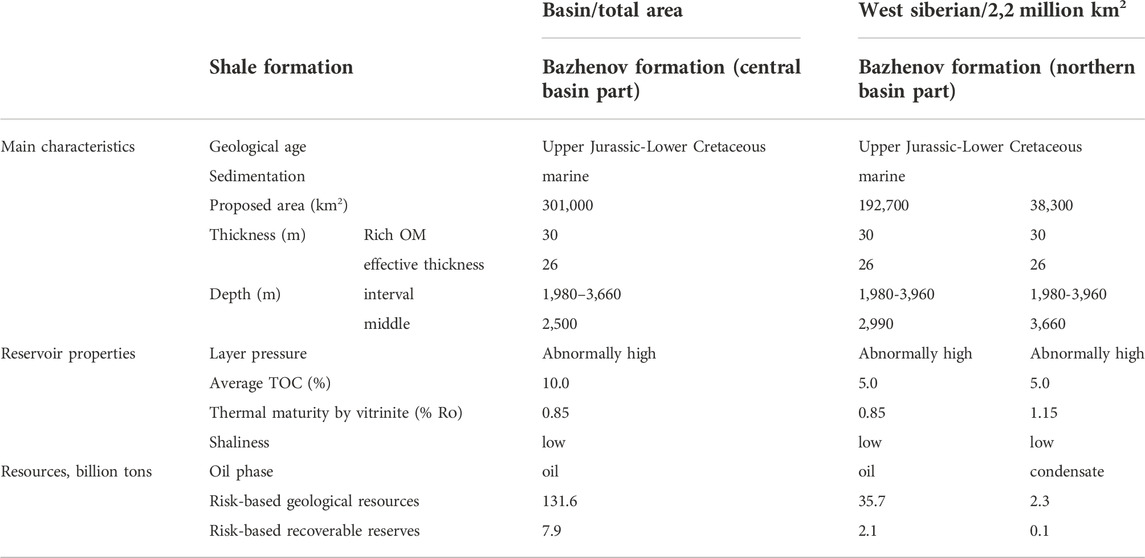
TABLE 1. Oil resources in the Bazhenov formation (EIA, 2013).
In the Bazhenov formation, parautochthonous bituminous rocks are recorded at the macro level only in highly fractured radiolarite layers—the siliceous-radiolarian litho-physical type. The main volume of the pore space of the clay-carbonate-siliceous mineral mass of rocks is related to voids formed due to the dissolution of radiolarian skeletons (Jarvie, 2012b).
The diameter of the voids of dissolution of radiolarian skeletons reaches 100 microns, the length is 250 microns, and some of these voids can later be partially or completely dolomitized. They were determined using an electron microscope (Kontorovich et al., 2018). In addition to micro-caverns of radiolarian dissolution, many smaller voids are present in the siliceous mass of rocks. These areas are composed of quartz microcrystals (Dakhnova et al., 2018; Cherepovitsyn et al., 2018), and the pores themselves are voids between individual crystals or clusters of them. The void space is filled with mobile micro-oil, and the rock can fluoresce under ultraviolet light. One of the world’s largest intracratonic West Siberian oil and gas basin, which occupies up to 2.7 million square kms and brings the country about 50% of its oil production per year in Russia and more than 80% of gas production, is also of interest today as a promising source of unconventional hydrocarbons contained in black shale formations.
The US Department of Energy’s Information Agency (EIA, 2013) provides estimates for 41 countries where technically recoverable resources are estimated at 204 trillion m3 of gas and 47 billion tons of oil, including oil from dense reservoir rocks. In oil assessment, Russia is the leader with 10 billion tons (only the Bazhenov formation assessment), and in terms of gas with an estimate of almost 8 trillion m3 of gas, it ranks 9th in the world (Prischepa and Averyanova, 2017). The most pressing issue here is the phrase “technically recoverable resources”, since today the industrial extraction technology for the Bazhenov formation is under development.
Large-scale studies of recent years (Rogozina, 1983; Kiryukhina et al., 2013b; Varlamov et al., 2020) have estimated the distribution of OM in rocks of the Bazhenov formation in Western Siberia, reconstruct its content at the beginning of catagenesis, and thus more reasonably approach the problem of estimating residual and non-migrated mobile hydrocarbons (Bazhenova and Dakhnova, 2014; Kontorovich et al., 2018). The potential of the Bazhenov formation according to these studies is estimated to be even higher than the Energy Information Administration estimates and amount to 25 billion tons of recoverable oil resources with a recovery factor of 0.03.
An important stage in the tectonostratigraphic development of the basin occurred in the Volga-Early Berrian period, when it was submerged in the central part of the basin (an area of about 1 million square meters). Sediments were formed in deep-water (from 300 to 700 m) (Ulmishek, 2003) stagnant conditions with hydrogen sulfide contamination, which regulated the biological productivity of benthic fauna and the degree of fossilization of OM, so in an anoxic environment, siliceous clays were deposited at a low rate, sometimes to varying degrees carbonate, enriched with OM, with a thickness of 20–40 m, sometimes up to 60 m. Thus, the geochemical situation in the sediments during the accumulation of OM in the Bazhenov formation was sharply reduced (siderite-pyrite and pyrite geochemical facies). The loss of OM during the anaerobic period of diagenesis was up to 35% (generation of biogenic methane) (Neruchev, 1986).
Next, after the Bazhenov formation, in terms of potential, the high-bituminous strata on the territory of Russia are the Upper Devonian deposits, which include the stratigraphic Domanik horizon.
In the Timan-Pechora and Volga-Ural provinces, according to VNIGRI studies (Neruchev, 1986; Belonin and Makarevich, 1994; Bazhenova et al., 2008; Bushnev and Burdelnaya, 2013; Prischepa et al., 2014; Stupakova et al., 2015; Averyanova and Morariu, 2016; Prischepa and Averyanova, 2017; Belozerov and Gubaidullin, 2020), dense clay, carbonate-clay and siliceous-clay rocks, primarily enriched with scattered OM, in the range of the Upper Devonian (Middle Frasnian-Famenian)—Lower Carboniferous (Tournaisian) parts of the section are classified as “Domanik-type” deposits. The stratigraphic range of their development is quite wide (Rzhonsnitskaya and Kulikova, 1990) from the actual Domanik (Semilukian) horizon of the Middle Frasnian age, including the Upper-Frasnian-Lower-Famenian (Vetlasyansky, Sirachoysky, Yevlanovsky, Livensky, Volgogradsky, Zadonsky, Yelets horizons) and Upper-Famenian-Lower Carboniferous (Lebedinsky, Zelenetsky horizons and Tournaisian stage) deposits. In both Timan-Pechora Province (TPP), and in the Volga-Ural OGP, they have traditionally been considered as strata that include oil and gas source rocks enriched in OM.
Due to the established practice of determining oil and gas bearing strata as a combination of reservoirs and fluid traps, Domanik-type strata with poorer reservoir properties and unstable oil and gas inflows from vertical wells were not considered as oil and gas-productive.
The attitude towards low-permeability reservoirs of high-bituminous formations is changing. So, according to Fortunatova (Fortunatova et al., 2021). Thus, the reserves of open unconventional deposits in the Troitsky, Krasnogorsky, Leshchevsky, and South-Nepryaevsky fields have been prepared for examination and registered in the State balance. The results of geological exploration in the Orenburg and Samara regions aroused a great interest of oil companies in areas that are promising for searching for unconventional oil deposits of the Domanik type.
In the North-East of the Siberian platform, the Kuonam formation is widely distributed, and is also referred to as being of the Domanik type (Figure 1).
It is represented by Domanikites (a term applied to thicknesses with TOC content in the range from 1 to 2%), calcareous-clay and calcareous-siliceous shales, marls, and clay limestones. The thickness varies from 20 to 70 m; trilobite fauna is found; stratigraphically, it belongs to the lower-middle Cambrian (Amginsky stage). The Kuonam formation comes to the surface in the section on the river Molodo, etc. The rocks of the formation and its facies analogues are considered by many researchers to be the main oil-producing strata of the region. The concentration of TOC is on average from 0.1 to 1%–3%, for individual rock differences (up to 15%–20%). The degree of transformation of OM, that called stages of catagenesis (according to the well-known classification of Vassojevich (Vassoevich, 1968) it varies from mesocatagenesis MK1-MK2 (Ra 7.0-8.2) and [in places of surface access and shallow occurrence) to MK4 (Ra 9.0-9.8) and apocatagenesis (АК) (Ra 10.7-13.0)].
The relevance of studying the Kuonam formation of Eastern Siberia as a potential source of shale oil is significantly less in terms of their possible industrial significance due, firstly, to the underdeveloped infrastructure. The West Siberian, the Timan-Pechora, and Volga-Ural provinces are more attractive from the point of view of studying the potential of non-traditional sources of raw hydrocarbons in these regions due to their more developed infrastructure, as well as due to the gradual depletion of traditional hydrocarbon reserves (Gubin, 2004; Guidelines for the Practical Evaluation, 2010).
The Kuonam formation is certainly worthy of study, but primarily as an oil and gas source layer, the potential of which served as the basis for the formation of accumulations of traditional hydrocarbon species in the overlying sediments. At the same time, its geological and economic significance as a source of shale oil and shale gas is not comparable to those of the typical Domanik deposits of the West Siberian, Timan-Pechora, and Volga-Ural OGP (Idelson et al., 1990).
To complete the description, it is also necessary to name the Kum and Khadum formations of the Paleogene of the Ciscaucasia, as well as the Pileng formation of the Neogene of Sakhalin. The concentration of ТОС (
On the territory of Russia and the former Soviet Union’s several sites can be attributed to Domanikoid mechanisms of action, certainly not of such significance as those aforementioned, but also interesting as an object of study are as follows: The graptolite shales of the Silurian of the Baltic States (Russia, Kaliningrad region), Suchan formation of Upper Cambrian of the Siberian platform; Redkin formation of vend of Moscow syneclise and kukersite of the middle Ordovician of the Leningrad region and Upper Jurassic oil shale in the Volga-Ural and the south of Timan-Pechora region. Of course, all of them require an appropriate “inventory” in terms of their oil and gas generation and storage capabilities.
This study is aimed at clarifying individual parameters and methods for assessing hydrocarbon resources preserved in primarily enriched strata with OM related to oil and gas source in several sedimentary basins of the Russian Federation. It is based on complex laboratory studies of natural outcrops samples and core wells. Also, based on interpretation of data from geophysical studies of wells and the results of seismic surveys on a network of regional profiles, which made it possible to refine and supplement data on the distribution by area and section of high-carbon rocks, distribution by lithotypes, geochemical characteristics of OM and extracts, filtration and reservoir properties of the section of the Domanik-type sediments.
The methodology of the work involved a number of sequential steps, including clarification of the geological structure of the intervals of the section of the high-carbon strata of the Upper Devonian (Middle Frasnian-Famennian) and Tournaisian stage of carbon related to the main oil and gas producing on the territory of Volga-Ural and Timan-Pechora provinces, including their geochemical and petrophysical features.
Such sequential steps included:
1. Identification of characteristic features of high-carbon deposits of the “Domanik type”.
2. Determination of the stratigraphic interval of the distribution of deposits primarily enriched with OM, related to the “Domanik type”.
3. Determination of the area of development of each of the selected stratigraphic units related to the Domanik-type deposits.
4. Determination of the lithological composition (microscopic and petrographic studies of the sections) and lithotyping of the Domanik-type deposits.
5. Assessment of geochemical features (laboratory study of bituminous extracts and pyrolytic studies of core samples), distribution and degree of transformation of OM of high-carbon deposits of the “Domanik type”, confined to different lithotypes and zones differing in facies conditions of formation.
6. Assessment of the petrophysical parameters of the isolated lithotypes in the of the Domanik-type sediments.
7. Identification of typical geochemical sections for all facies zones and stratigraphic intervals of the development of the Domanik-type deposits.
8. Mapmaking of the current concentration of organic carbon and the catagenetic maturity of OM by bituminological and pyrolytic studies.
9. Recalculation of the organic carbon content in the Domanik-type rocks at the beginning of catagenesis using balance equations for three types of OM.
10. Determination of the mobile part of bituminous (separation into residual kerogen and parautochthonous bituminous) preserved in oil and gas source deposits of the Domanik type after migration of generated hydrocarbons.
11. Clarification of the methodological approach to the assessment of oil and gas resources of high-carbon deposits of the Domanik type.
12. Assessment of the resource potential of the Upper Devonian-Tournaisian deposits of the Domanik type of the Timan-Pechora OGP.
13. Assessment of the resource potential of the Upper Devonian-Tournaisian deposits of the Domanik type of the Volga-Ural OGP.
14. Assessment of the possibility of using the developed approach to high-carbon deposits of the Khadum formation (Early-Middle Oligocene) of The North-Pre-Caucasian OGP and the Kuanam formation (Lower Middle Cambrian) of the Leno-Tunguska OGP.
A specific feature of high-bituminous strata enriched with organic carbon the ability to generate and preserve generated hydrocarbons within single strata or in low-permeable boundary strata associated with it above and below the section (Neruchev, 1962; Neruchev and Smirnov, 2007; Bazhenova et al., 2008; Kiryukhina et al., 2013a; Bazhenova and Dakhnova, 2014; Sannikova et al., 2017; Kontorovich et al., 2018). If there are high-quality screening layers above and below the horizon, the reservoir properties of rocks are “preserved” and deposits of the traditional type are formed in the Domanikoid at the generation site, often with abnormal high pressure (for example, the Salymskoye field in Western Siberia). If there is either no upper or lower cap, the fluids are forced out (squeezed out) in an upwards or downwards direction. As a result, high-bituminous strata are significantly compacted, lose their traditional reservoir properties, and can be classified as low-permeable, dense reservoirs containing accumulations of unconventional hydrocarbons. This aspect determines the uncertainty in the exploration process and the lack of clear recommendations when determining the selection of objects and areas for licensing.
In general, it can be noted that the unconventional oil and gas system differs from the traditional one primarily in that the object of industrial evaluation is hydrocarbons that have not been displaced from OGSS, after their generating (preservation) due to low permeability that does not provide further migration routes to traps or dispersion.
Geochemical methods play one of the most significant roles in the overall complex of studies aimed at predicting the oil and gas potential of the Domanik-type deposits. Their use in conjunction with other geological and geophysical methods significantly increases the information-richness of the assessment (Tissot and Velte, 1981; Espitalie et al., 1993; Stupakova et al., 2015; Carayannis et al., 2019; Ilinova and Chanysheva, 2020).
Also considered methodological approaches to identifying effective oil-saturated thicknesses when combining field geophysical data and Rock-Eval data to identify promising objects in the depth section.
The residual hydrocarbon potential of the oil and gas source shale strata is determined by the conditions of sedimentation and burial of high-carbon deposits, the history of their immersion, migration (expulsion) opportunities, the scale and speed of hydrocarbon generation, their redistribution, and preservation opportunities.
There are many approaches to estimating the resources of hydrocarbon accumulations confined to low-porosity and low-permeability strata of oil and gas source formations.
The basis of the study is the refinement of maps of the lithological-facies zonation and thickness of the Domanik-Tournaisian complex, the distribution of concentrations of OM and the assessment geochemical and lithological heterogeneities of a section for the allocation of the main types of organic carbon distribution in representative sections.
Based on the example of the Timan-Pechora sedimentary basin, it was revealed that the high-carbon strata were formed on the part of the basin area only in the Middle Frasnian, on the other part—in the Middle-Late Frasnian-Early Famennian period, in the limited eastern part—in the Middle Frasnian-Early Tournaisian period.
The methodology for assessing the generation, migration, and preservation of hydrocarbons in the generation column is based on a detailed dissection of the Domanik-type deposits and its formation analogues with the allocation of basic lithotypes, that each has its own geochemical characteristic of OM. The reference is also related to sedimentation conditions from shallow-sea shelf to relatively deep-water scenarios. According to the results, three strata were typed in the age range from the Middle Frasnian to the Late Famennian-Tournaisian periods of the Upper Devonian.
The resources are estimated by the volumetric geochemical (genetic) method based on the capabilities of the rock to generate hydrocarbons. The generation potential of the oil and gas primary shale strata and the degree of its realization are estimated using this method.
The methods used to evaluate the industrial significance of shale hydrocarbon accumulations in North American projects are based primarily on data from test studies of wells and are distributed or interpolated to zones of influence (drainage). Such approaches are very reliable in determining the necessary parameters and characteristics for making management decisions on the development of work on a specific area, but they are extremely costly and inefficient for assessing the prospects of the entire area (basin) for the development of high-carbon strata.
Currently, two approaches are the most common in assessing the resources of non-traditional strata. Both methods can be employed for estimating quite traditional hydrocarbon accumulations: the standard volume method and the volume-genetic method (with modifications of the balance model or basin modelling). The difference between the first method and the assessment of traditional accumulations is the involvement of low-pore and low-permeable reservoirs in effective thicknesses, as well as the use of separation of layers with mobile and stationary oil. The second approach is increasingly being used. This approach is based on estimating the volume of possible generation of hydrocarbons from the oil and gas generating strata, estimating the volumes that have left the generation strata (expulsion), and the possibilities of preserving (residual oil) directly in the generation strata or in low-porosity strata bordering it that are not a transit-path for the resulting hydrocarbons.
A quantitative model of the generation of oil and gas in the process of transformations (catagenesis) for basic types of OM rocks are well developed in Russia regarding high-bituminous sources that was reflected in the works of Neruchev, Kontorovich, and Bazhenova. These studies, along with other theoretical developments (Kontorovich et al., 1967; Halimov and Melik-Pashaev, 1980; Schamel et al., 1994; Pairazian, 2003; Jarvie, 2012a; Prischepa et al., 2015) allowed a better understanding of the hydrocarbon potential of these strata, which, of course, can be used in the debate around current issues.
Thus, one of the most well-known approaches to the quantitative model of oil and gas generating (Peters et al., 1993; Magoon and Valin, 1994) based on the possibility of using systematic data on the composition of OM and bituminous media at different stages of catagenesis. However, this requires a huge amount of detailed geochemical studies of OM, which can be conducted in the presence of a representative selected core. In this regard, a method of quantitative modelling of oil and gas generation for the main genetic types of OMs was developed, which can be used as a basis for assessing oil and gas formation in any oil and gas basin (Lopatin et al., 2003).
One of the important points that require clarification when discussing the issues raised in the article is the terminology used in parts of the stages of transformation of sediments enriched with dispersed organic matter (DOM) and identified as oil and gas producing and oil and gas containing.
Two main approaches are used to determine the main stages of catagenesis (temperature changes). First is using indicators of the reflectivity of vitrinite of carbonaceous detritus (refractive index of collogalgenite). Second is by the characteristic colors of the insoluble part of OM or by the color of the substituted organic residues.
Vitrinite is a carbonaceous inclusion (micro-component) in a rock formed from woody tissue due to coalification of lignin and cellulose and characterized by a wide distribution, homogeneity, physico-chemical characteristics and, most importantly, almost irreversibly reacts to changes in temperature conditions. Therefore, by the reflectivity of vitrinite, it is possible to identify the stages of catagenesis of rocks and OM contained in it and, in fact, vitrinite fixes the maximum temperature of warming.
In 1961, the famous Soviet carbon petrographer I.I. Amosov proposed to determine the stages of coalification by the reflectivity of vitrinite in air environment Ra and cedar oil (R°) (Ammosov and Tan, 1961). The reflectivity of vitrinite is the ratio of the intensity of the luminous flux of the specified wavelength reflected from the polished surface of the macerals of vitrinite group (humite) to the intensity of the luminous flux incident perpendicular to this surface, as a percentage of Ra = Rair, Ro = Roil.
Considering the results of Amosov’s research, a scale of catagenesis was developed, noting its gradations based on the reflectivity of vitrinite [42, 48 76], which is widely used at time of writing (Table 2); however, this universal development has certain limitations in practical use. For example, vitrinite, as a rule, is absent in marine sediments with sapropel OM. Moreover, with high rock-transformation, the reflectivity of coals and vitrinite closing with each other and therefore the practical use of the reflectivity of vitrinite meets certain difficulties.
The absence of carbonaceous substances in marine sediments forced Parparova and co-authors in 1973 to develop the scale, and Neruchev et al. (1976) refined it in 1986 (Rogozina, 1983). This scale of catagenesis was developed based on a complex of studies of concentrates of debituminised kerogen by sapropel micro-components (Table 2). The scale of catagenesis developed by Vassojevich is widely used in Russia and neighboring countries, however, in the United States, Germany, the United Kingdom, and some other countries, other ratios of lithogenesis gradations and carbonaceous scales are used. Various schemes of catagenesis were compared by Vassojevich (Vassoevich, 1968) (Table 3). There are other methods for determining the degree of transformation of dispersed OM. For example, in Precambrian and Lower Palaeozoic sediments devoid of carbonaceous inclusions, vitrinite in particular, the refractive index of the micro-components of the dispersed OM as colloalginite, collohitinite, and pseudovitrinite is used.
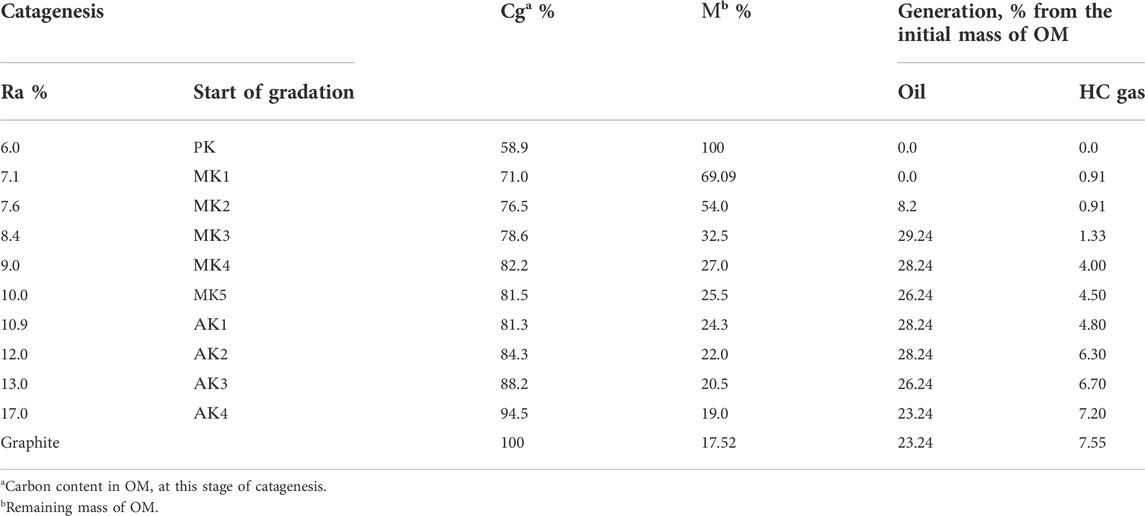
TABLE 3. Generation of oil, hydrocarbon gas and other volatile products of sapropel OM for recalculating at the beginning of catagenesis (Kontorovich et al., 2018).
Thus, for a more unambiguous understanding of the transformation stages of OM when assessing the volumes of generated hydrocarbons at the corresponding stages of catagenesis, this article presents both the corresponding stages widely used in Russia (from PK1 to AK5) and the reflectivity of vitrinite, indicating the corresponding stages of coalification, widely known and used in the scientific literature; this is based on information about the genetic type of OM in a particular object under study and data on the degree of catagenesis of OM therein, as well as balance quantitative models of oil and gas formation obtained as a result of long-term detailed geochemical studies of the OM of oil and gas source rocks of the Volga-Ural, West Siberian, East Siberian oil and gas regions and other regions of Russia (Neruchev, 1962; Neruchev et al., 1976).
Generalized quantitative models for the generation of oil, hydrocarbon gas, and other volatile products were developed for sapropel-type OM, humic OM, and low-concentration oxidized sapropel OM (Bazhenova, 1994; Bazhenova, 2016).
Oil and gas formation models used in the present work to assess hydrocarbon potential of shale formations of Russia are widely known and mostly developed for evaluation of amount of generation and expulsion of hydrocarbons from source rock formations (Kontorovich et al., 1967; Larskaya, 1983; Magoon and Valin, 1994; Schamel et al., 1994; Kleshchev et al., 2000; Kiryukhina et al., 2013a; Kiryukhina et al., 2013b; Kiryukhina et al., 2015; Fortunatova et al., 2019a; Fortunatova et al., 2019b). The highest oil-source potential is characterized by sapropel OM (kerogen types I-II). Data on the generation of oil, hydrocarbon gas and other volatile products by sapropel OM obtained by Neruchev are summarized in Table 3 (Lopatin et al., 2003).
The main stages of transformation of organic matter according to the works of Neruchev are described below (Neruchev, 1962; Neruchev et al., 1976; Neruchev, 1986; Neruchev et al., 2006).
At the stage of protocatagenesis (Ra 6.0-7.1), oil generation does not occur, and the generation of hydrocarbon gas is very insignificant — 0.9% of the mass of the initial OM (Figure 3; Table 3) (catagenesis zones for Domanik are shown in Figure 3). At the beginning of the MK1 (Ra 7.0-7.5) gradation, oil generation by sapropel OM is also insignificant, but by the beginning of the MK2 (Ra 7.5-8.2) gradation it reaches 8.2% of the initial mass of OM (Putikov et al., 2019).
The predominant part of oil is formed during the thermal destruction of sapropelic OM at the MK2 (Ra 7.5-8.2) catagenesis gradation (Figure 3; Table 3) and reaches MK3 (Ra 8.2-9.0)—29.24% of the initial mass of the OM at the beginning of catagenesis. At higher grades of catagenesis (from MK3 to the end of AK (Ra 10.6)—apocatagenesis), oil generation is not significant at all, but the process of formation of hydrocarbon gas, which is dominated by methane, is activated (Figure 3). On gradation of MK3 (Ra 8.2-9.0) hydrocarbon gas generation accounts for 2.7% of the initial mass of OM and by the end of metacatagenesis reaches 4.6% and by the end of apocatagenesis, some 7.5% of the initial mass of OM. HC gas of 70%–80% is formed after the completion of oil formation, during the main phase of gas formation.
Humic OM has a lower oil-source potential (Table 4). HC gas is generated by humus OM at all stages of catagenesis, but unevenly. In protocatagenesis (Ra 6.0-7.1), 1.6% of the hydrocarbon gas is formed, at the stage of the main phase of oil formation—only 0.896 of the initial mass of the OM at the beginning of catagenesis. Further, the generation of HC gas is activated, the main phase of gas formation is manifested. By the end of mesocatagenesis (Ra 9.0-10.0), 5.7% is formed, and by the end of apocatagenesis, some 35.27% of the initial mass of the HC gas is formed. Thus, the predominant part of the HC gas (>80%) is formed during the main phase of gas formation.
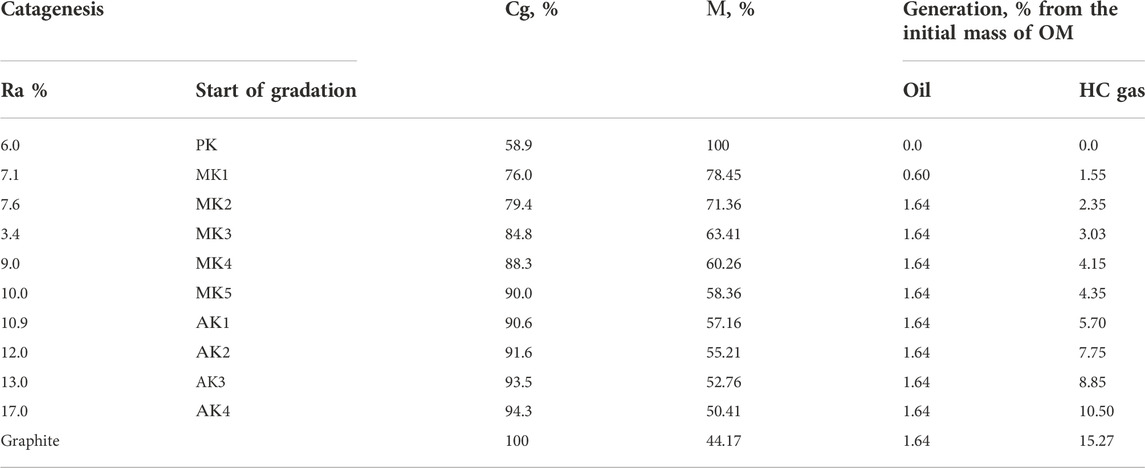
TABLE 4. Generation of oil, hydrocarbon gas, and other volatile products by humic OM for recalculation at the beginning of catagenesis (Neruchev and Smirnov, 2007).
The oil and gas source rocks often contain mixed forms of sapropel-humus and humus-sapropel OM, rather than pure sapropel or pure humus. Knowing the ratio of sapropel and humus components in the OM of the studied geological object and using the data provided (Tables 4, 5), the amount of oil and gas produced for any mixed composition of the OM may be calculated.
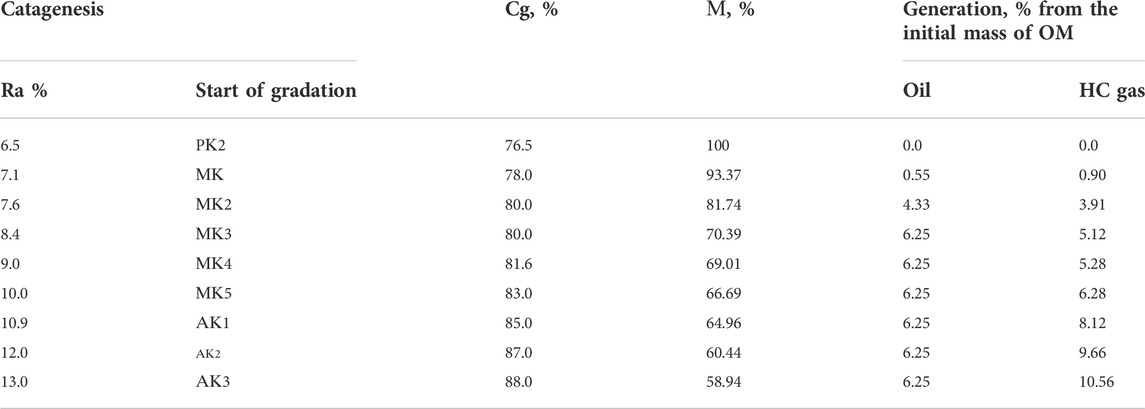
TABLE 5. Generation of oil, hydrocarbons, and other volatile components by low-concentration oxysorbosapropelic OM.
By the beginning of MK1 (Ra 6.0-7.1) gradation, oil generation does not exceed 0.6%, by the end of MK2 (Ra 7.5-8.2) gradation, no more than 1.64% of the initial mass of the OM at the beginning of catagenesis, and at higher grades of catagenesis stops. Weak oil generation by humus OM at grades MK1-MK2 (Ra 7.0-8.2) is proportional to the amount of sapropel and humus components.
Table 5 lists data on the generation of oil and gas by low-concentration oxysorbosapropelic OM. Intensive oxidation of OM at the stage of diagenesis significantly reduced its oil-source potential. Oil generation from the beginning of MK1 (Ra 7.1-7.5) gradation to the end of the MK3 (Ra 8.2-9.0) catagenesis gradation for this type of OM is only 6.25% (compared to 28.24% for sapropel OM). The generation of HC gas is slightly higher than that of sapropel OM and at the AK3 (Ra 13-14.0) gradation reaches 10.56% of the initial mass of the OM at the beginning of catagenesis.
The given data of the oil generation used in this study are used for recalculating the volumes of organic carbon of OM at the beginning of catagenesis and for estimating the volumes of generation, expulsion, and volumes of hydrocarbons preserved in the generation strata, but separated from the HC matrix in highly-bituminous strata of the Russian Federation.
Estimates of the volume of generation and expulsion from the OM of the oil and gas source strata of Russia are widely presented in the works of Neruchev, Gurrari, Nesterov, Kontorovich, Bazhenova, among others (Neruchev, 1962; Kontorovich et al., 1967; Gurari, 1980; Neruchev, 1986; Bazhenova, 1994; Shimansky et al., 1994; Kontorovich et al., 1997; Bazhenova, 2016; Varlamov et al., 2017; Varlamov et al., 2020).
Estimates of residual oil in the generation strata have only recently been reflected in publications on the prospects of shale basins in Russia. Estimates of the so-called technically recoverable oil of shale formations in Russia were given in the work of Ahlbrandt et al. (2005), where they were estimated at 5.3 billion tons of oil and 4.3 trillion m3 of gas for the Domanik formation of the Timan-Pechora and Volga-Ural SB, 15.7 billion tons and 4.7 trillion m3 for the Bazhenov formation of the West Siberian SB, and in 4.5 billion tons and 5.9 trillion m3 for the Khadum and Maykop formations of the Ciscaucasia (Guliyev et al., 2018; Kerimov et al., 2021). In the work of Bazhenova (Bazhenova, 2016), where the total scale of “residual oil” in the Bazhenov formation of Western Siberia was estimated at 1.700 billion tons. In the Domanik formation of the Timan-Pechora OGB in 176.5 billion tons (58.6 billion t—D3sm; 117.9 billion tons D3f3-C1t). In the Volga-Ural oil and gas basin (OGB) in 758 billion tons (218 billion tons—D3st; 540 billion tons—D3f3-C1t). In the Kuonam formation G1-2 of the East Siberian platform in 250 billion tons. In the Kum and Khadum formations of the Ciscaucasia—197 billion tons. These estimates from the work (Bazhenova and Dakhnova, 2014) most likely indicate the share of generated, but not yet emigrated from the thickness of generation (dispersed therein) of hydrocarbons (Martirosyan et al., 1998).
Estimation of resources in the high-carbon shale layer of the territories of the Russian Federation that have been completed in recent years are listed in Table 6.

TABLE 6. Comparison of estimations of hydrocarbon resources of shale mother formations in Russia [after (Bazhenova, 1994; Bazhenova et al., 2008; Bazhenova and Dakhnova, 2014)* (Prischepa et al., 2014; Prischepa and Averyanova, 2017)** (Ahlbrandt et al., 2005)***].
A series of studies on the Timan-Pechora basin (Bazhenova, 1994; Belonin et al., 2004; Jarvie, 2012b; Averyanova and Morariu, 2016; Egorov et al., 2018) could be aimed at assessing the “residual” generation potential of the Domanik formation of the TPP, estimated 135.2 billion toe (oil potential—59.63 billion of t., gas potential—88.88 trillion m3) to 171.2 billion toe (oil potential—66.14 billion t., gas potential—123.88 trillion m3) and up to 225.4 billion toe (oil potential—152.7 billion tons, gas potential—61.8 trillion m3) when used with different kinetic spectra (Pepper and Corvi, 1995). In the meanwhile, the total amount of oil in the free pore space of the Domanik horizon when using kinetic spectra with different frequency factors and Pepper and Corvi kinetics is approximately the same at values of about 13.3 billion tons of oil (Pepper and Corvi, 1995; Sannikova et al., 2017).
According to the most relevant study (Belonin et al., 2004; Bushnev and Burdelnaya, 2013; Egorov et al., 2018; Fortunatova et al., 2019a; Fortunatova et al., 2019b), based on the study of the core of deep wells with a Domanik depth of 2,733–4,416 m; cores from five structural wells drilled in the Ukhta region of southern Timan with a depth of 50–300 m and samples from natural outcrops of Domanik horizon rocks in the Ukhta region of southern Timan, the resources of the siliceous-carbonate high-carbon Domanik formation were determined using the volume-genetic and volume method.
According to the selected facies zones, considering the zoning of catagenesis, the volume of oil resources preserved in the Domanik strata in the Timan-Pechora sedimentary basin is estimated, i.e. from 143.6 (Fortunatova et al., 2019a) to 225 billion tons (Sannikova et al., 2017).
To clarify the areal and stratigraphic boundaries of the distribution of the high-carbon formation, as well as the distribution of organic carbon (TOC) along the Domanik sediments and its overlying facies analogues, litho-facies maps were used as the basis of the study, field (seismic data) and geophysical data of wells (logging) that uncovered these deposits in the Timan-Pechora sedimentary basin (more than 350 wells) with reference to the main isolated lithotypes in the range of the Domanik-Tournaisian deposits (separately for Domanik, Upper Frasnian-lower Famennian and Famennian-Tournaisian parts of the section). In the northwest of the basin, there is an area of absence of the Domanik deposits (Figure 2).
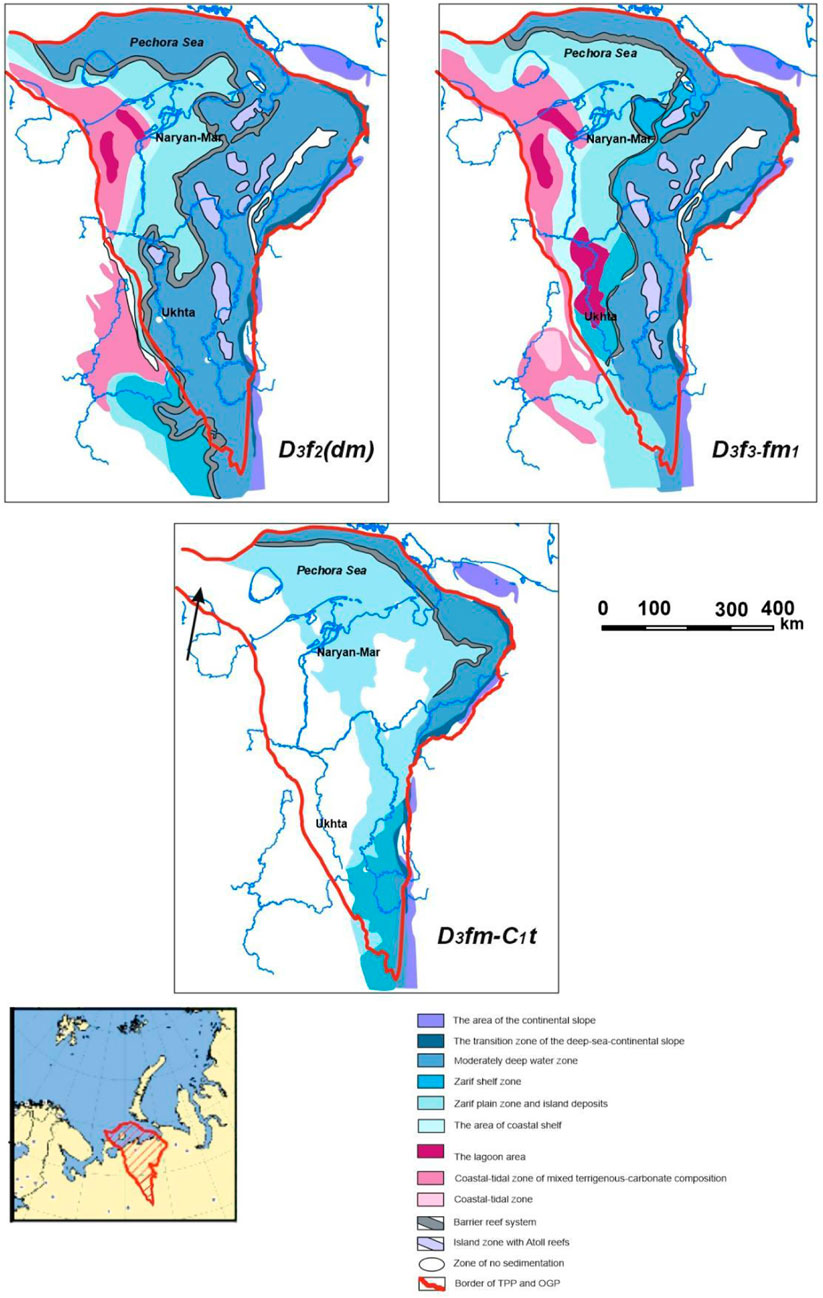
FIGURE 2. Lithological-facies map of the development of the Domanik and Domanikoid deposits of Middle-Frasnian, Late-Frasnian and Famennian-Tournaisian stages in the Timan-Pechora OGP (Prischepa and Averyanova, 2017).
Lastly, and of the least significant, albeit important for the easternmost regions of the sedimentary basin, is the presence of mainly marl and сlay carbonate, which can also be attributed to the high-carbon part of the Famennian formation and the lower part of the Tournaisian stages; these are divided into two types in the zone of catagenesis MK2 (Ra, occupying an area of distribution of about 15 thousand km2 with a total thickness of the high-carbon part of the section up to 20–30 m and concentrations of TOC 2%, in the zone of catagenesis MK3 (Ra 8.2-9.0), occupying an area of distribution of about 60 thousand km2 with a total thickness of the high-carbon part of the section up to 30 m and TOC concentrations of 1.0%.
Samples of the Domanik deposits from wells with a small depth of the Domanik deposits contain both Types I and II, the its degree of maturity is slightly higher (TMAX 413°C–429°C) than on outcrops (gradation of catagenesis MK1-2 (Ra 7.0-8.2). The content of TOC therein varies from 2 to 15%, and in sapropelites exceeds 20%. The hydrogen index (HI) of kerogen contained in rocks of this type is 360–800 mg of HC/g TOC (Fortunatova et al., 2021).
Previously, an attempt has already been made without noting the mapped correction of the average organic carbon content in the Domanik TP SB, tying them to the main lithotypes, and without comparing the data on filtration and thickness properties and saturation (which was fully used in this study) to evaluate the generated, initially migrated, but remaining in the generation strata the “mature” hydrocarbons based on the identification of the zonality of catagenesis (Pairazian, 2003; Sobolev et al., 2017).
In the present research, an attempt is made to estimate the hydrocarbon resources in the Domanik deposits and in their overlying formation analogues using balance models of oil and gas formation by Neruchev (Neruchev et al., 1976), considering the trends revealed in the distribution of pore space (tomographic studies) and oil saturation associated with lithotypes and zones of catagenesis (Weisberg et al., 2018; Torba and Nikiforova, 2019).
The catagenesis maps were made based on the data obtained during the study of Domanik rocks by bituminological research (VNIGRI data (Prischepa and Averyanova, 2017) on more than 2000 samples) and also based on Rock-Eval method data on the results of their geochemical studies (more than 350 core samples and 200 outcrop samples) and more than 350 analyses according to the work of Fortunatova (Fortunatova et al., 2019b). Approaches to determining the degree of catagenesis based on bituminological data are described in detail in (Neruchev, 1986; Bazhenova and Dakhnova, 2014).
According to Rock-Eval, the degree of OM catagenesis is determined according to the indications of Tmax (Neruchev et al., 1976). In the calculations, areas with Tmax less than 415°C were excluded (corresponding to grades PK1-PK2). Areas with Tmax of 415°C–425°C (correspond to grades PK3-MK1, corresponding to the entry into the main phase of oil formation) of the Domanik-type deposits in the Ukhta district of the TPP, are oil-bearing.
The catagenesis scheme for the Domanik-Famennian part of the TPP section is shown in Figure 3.
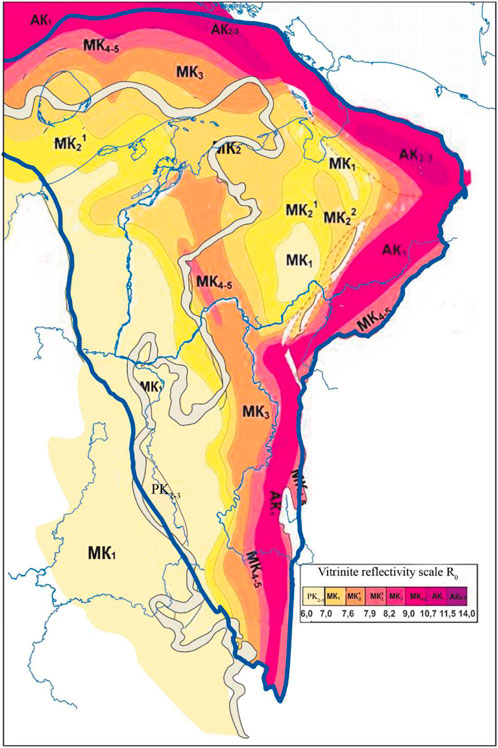
FIGURE 3. Catagenesis schematic map of the Domanik horizon (D3f2) of the Timan-Pechora province oil and gas complex (after Bazhenova et al. (Bazhenova et al., 2008; Bazhenova and Dakhnova, 2014).
The scheme of TOC distribution for the Domanik-Famennian part of the TPP section is shown in Figure 4.
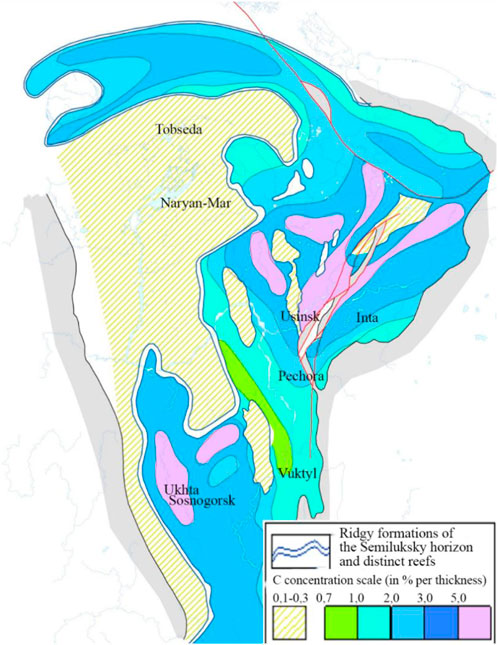
FIGURE 4. Schematic map of the averaged concentrations of OM in the Domanik horizon of the TPP (Bazhenova et al., 2008; Prischepa et al., 2014; Bazhenova, 2016; Prischepa and Averyanova, 2017).
Results that are significantly different from those above were obtained (Tables 6 and 7). The total oil resources estimated in accordance with two different methods (estimation of the pore space of Domanik strata occupied by soluble bituminous and estimation of the recoverable part of parautochthonous bituminous that did not migrate from the strata) differ by about 1.5 times (4.91 and 6.39 billion tons), which in principle is quite appropriate when there is a large spread of data on filtration and reservoir properties and pyrolytic studies of individual wells, as well as a limited number of kinetic spectra used. The volumes are quite adequate to the estimates obtained when identifying the most significant areas at depths corresponding to the zone of oil and gas formation of Domanik strata (Prischepa et al., 2014).
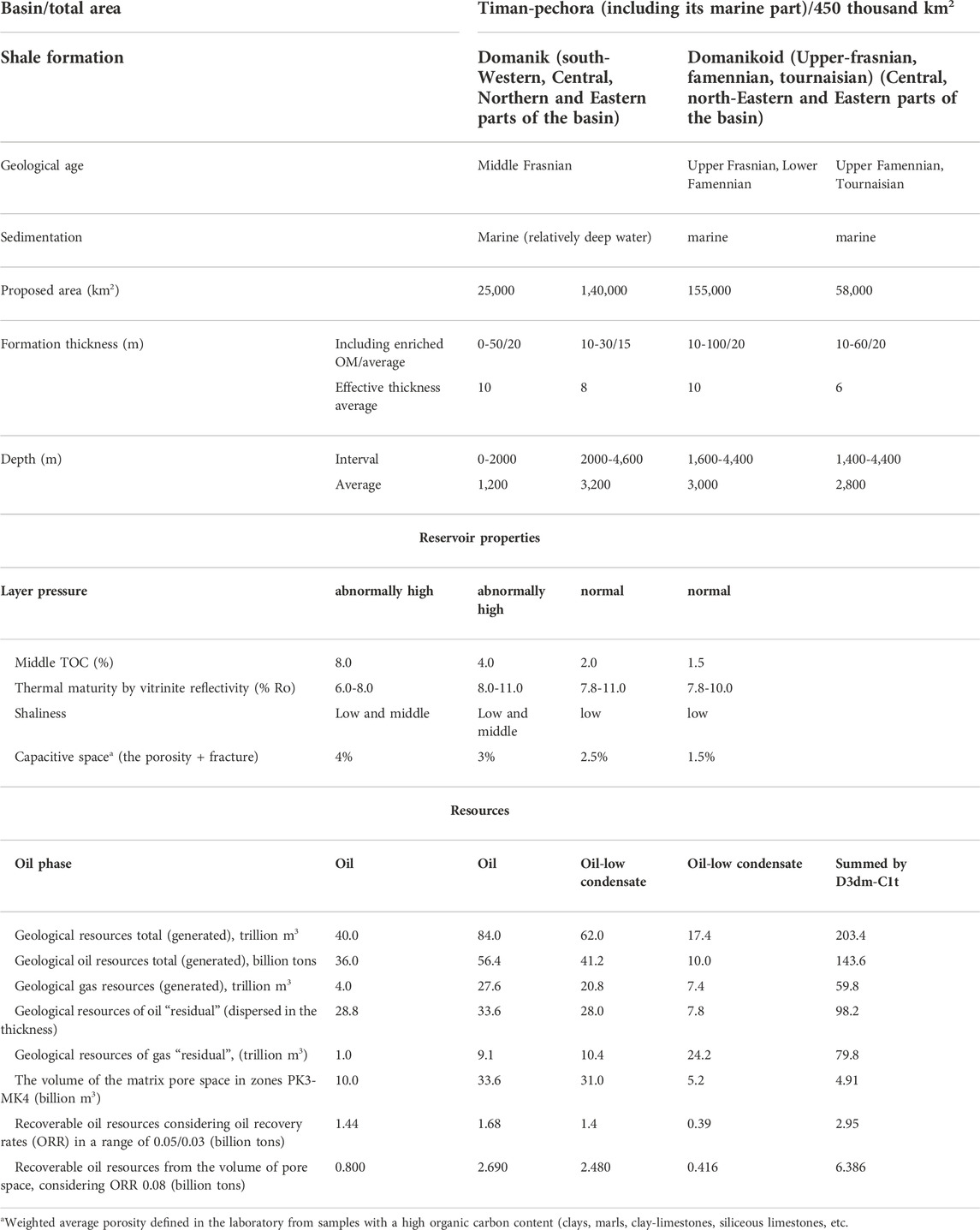
TABLE 7. Characteristics of the Domanik formation of the Timan-Pechora OGP and assessment of unconventional accumulations of hydrocarbons in the Domanik shale strata [according to the authors study using the balance equations (Neruchev et al., 2006)].
The estimation of the remaining resources scattered in the thickness of the Domanik deposits can be realized by the remaining hydrogen index of OM obtained based on pyrolytic data, as well as in accordance with the stages of catagenesis and the output of liquid and gaseous hydrocarbons from the corresponding type of OM.
The differences between the maximum possible output and current output (Tables 2–4) and the current values of TOC content are used. According to previous research (Sannikova et al., 2017), based on the results of modeling in Petromod, the remaining generating potential of the Domanik strata varies from 0 to 7.9 million tons/km2 (for the corresponding kinetic spectrum of the activation energy).
The greatest remaining generating potential of the Domanik deposits is noted in the south-western part of the Timan region, since this particular territory is characterized by a lower degree of maturity and the best initial geochemical parameters. According to our estimate, significantly lower density values were obtained for oil: from 0 to 3.2 million tons/km2 for the Domanik, from 0 to 0.36 million tons/km2 for the Upper Frasnian, and from 0 to 0.26 million tons/km2 (Table 8).

TABLE 8. Estimation of resources in the high-carbon shale layer of the Domanik of the TPP (Varlamov et al., 2020; Fortunatova et al., 2021).
The estimation of the proportion of syngenetic and epigenetic bituminous in the generation thickness was compared with the effective porosity, i.e. a combined volume method and an improved volume-genetic method were used (Table 7).
The difference in the volumes of hydrocarbons preserved (Kondrasheva, 2018; Makhovikov et al., 2018) in the generation strata in the dispersed state after the completion of expulsion processes and the volumes of generated oil that have signs of mobility and saturate the pore space (including those formed by the generation of hydrocarbons) can be estimated by involving laboratory core studies with a series of studies before and after bituminous extraction (Solovieva and Pavlova, 2007).
It is useful to compare the results obtained by different groups of researchers and those arising from use of different techniques. Thus, the use of the method of geological analogies with the selection of reference type sections, performed in the study of Fortunatova et al. (2019b); (Fortunatova et al., 2021) made it possible to estimate the potential of hydrocarbons in the Domanik deposits for the Timan-Pechora OGP (Table 8) (Martirosyan et al., 1998).
In general, they are estimated at 170.2 billion tons, which does not contradict previous results (Bazhenova et al., 2008; Kiryukhina et al., 2013a; Sannikova et al., 2017). Recoverable resources determined from the calculation of ORR giving values of 0.03 and 0.05 amounted to 5105.2 million tons or 8508.59 million tons, respectively) (Fortunatova et al., 2019b).
In each of the studies, the estimates used significantly different approaches and estimated different volumes of resources in terms of meaning and practical significance—concentrated zones of parautochthonous bituminous, preserved in the generation thickness, or volumes of scattered bituminous (unrealized potential). An attempt to separate these types of bituminous has already been made (Methodological guidelines for the quantitative, 1983), where it was shown that the value of the residual resources of Domanik and its facies analogues of TP OB (mobile bitumides that broke off from the matrix) it is 5.3 billion tons of oil and 4.6 trillion m3 of gas, and for the Volga-Ural OGP—is 6.5 billion tons of oil and 3.5 trillion m3 of gas, respectively. These figures for the TPP, in general, are comparable with the estimates of MSU (13.3 billion tons) “in free pore space”.
The use of a calculation technique akin to that above (the method of analogies with the allocation of reference sections of the Domanik wells for each of the assessed zones) in relation to the Domanik of the Volga-Ural OGP (Fortunatova et al., 2021) showed the following results (Table 8; Figure 5). In our opinion, they are overly positive because both the distribution areas, comparing with the Timan-Pechora basin, and the concentrations of TOC both on the thickness as a whole and when it is divided into separate lithological and stratigraphic divisions (from the Middle Frasnian to the Upper Famennian deposits) are comparable.
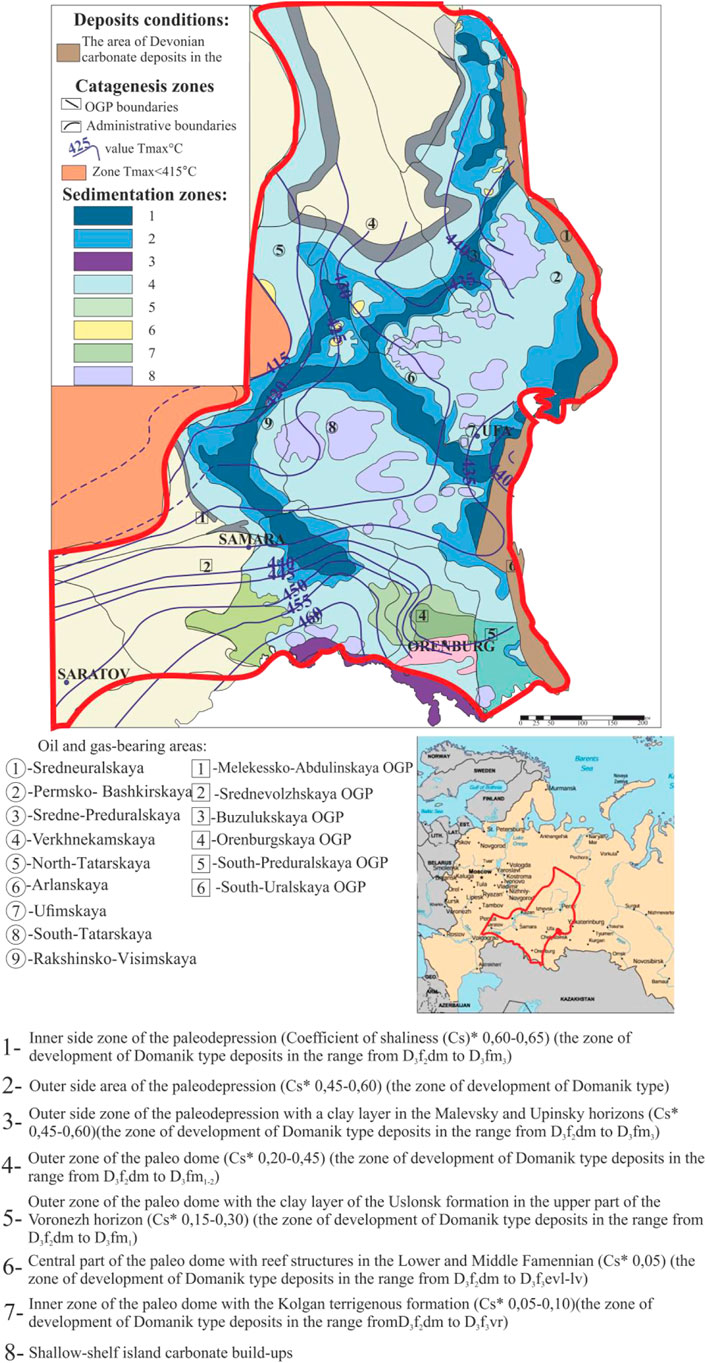
FIGURE 5. Lithological-facies map of the development of the Domanik and Domanikoid deposits in the Volga-Ural OGP (Fortunatova et al., 2019b; Varlamov et al., 2020).
Recoverable resources determined with an oil recovery factor of 0.03 amounted to 20.1 billion tons (Varlamov et al., 2017; Fortunatova et al., 2019b; Varlamov et al., 2020; Fortunatova et al., 2021). Based on the volumes of generated oil and gas determined in accordance with the balance models of Neruchev (Neruchev and Smirnov, 2007) the volume of “residual” geological resources of oil, in general for the Volga-Ural OGP in the high-carbon strata of the Domanik and overlying Frasnian-Famennian clay-carbonate-siliceous sediments was estimated at 82 billion tons, gas–29 trillion m3, which, with a recovery factor of 0.1 to 0.003, amounted to 6.5 billion tons and 3.5 trillion m3 (Prischepa et al., 2018). This is almost the entire range of coefficients in such projects. We used in the calculations, depending on the porosity, from 0.03 to 0.05. These values are conditional and are based only on available statistics (Smith, 1971). The estimation of resources using the method of analogies based on the allocation of reference sections, according to the Volgo-Ural OGP is displayed in Table 9.

TABLE 9. Resource estimate for unconventional accumulations of hydrocarbon in the high-carbon Domanik strata of Volga-Ural OGP (Prischepa et al., 2014; Varlamov et al., 2017; Fortunatova et al., 2019a; Fortunatova et al., 2021).
Resource estimation using the method of analogies based on the selection of reference sections for the Leno-Tunguska OGP is shown in Table 10 (Figure 6).
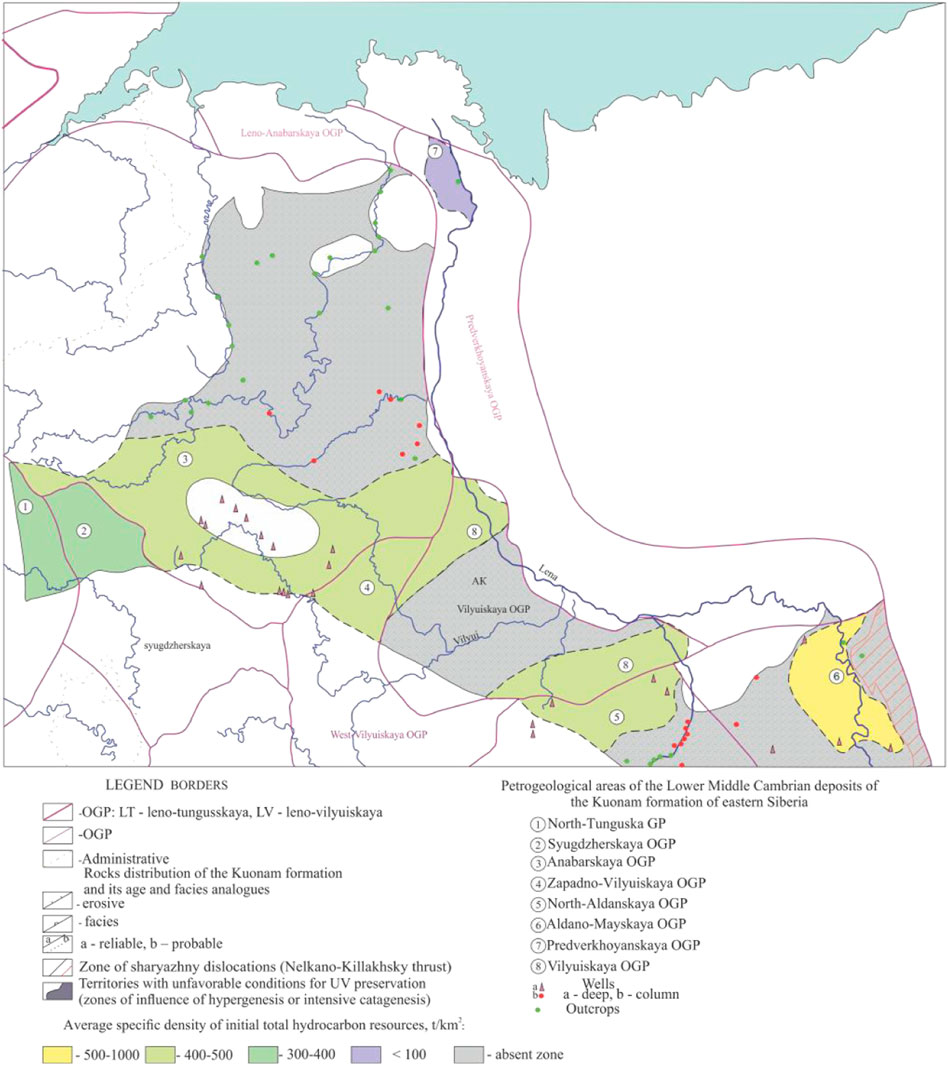
FIGURE 6. Distribution of the Kuonam formation within the Lena-Tunguska OGP (Smith, 1971).

TABLE 10. Estimation of unconventional hydrocarbon accumulations in the Kuonam shale formation of the Leno-Tunguska OGP (Smith, 1971; Fortunatova et al., 2021).
Estimation of oil accumulations unconventional geological resources in the Khadum formation with using the method of analogies for the eastern part of the North Caucasian-Mangyshlak OGP (Tersko-Kum depression) was made according to the research of Fortunatova as 8.03 billion tons; if we note the recovery factor 0.1-0.05 (1.09 billion tons), which is comparable with estimation based on the generation potential and the possibilities of preservation in the strata (0.8 billion tons) (Figure 7).
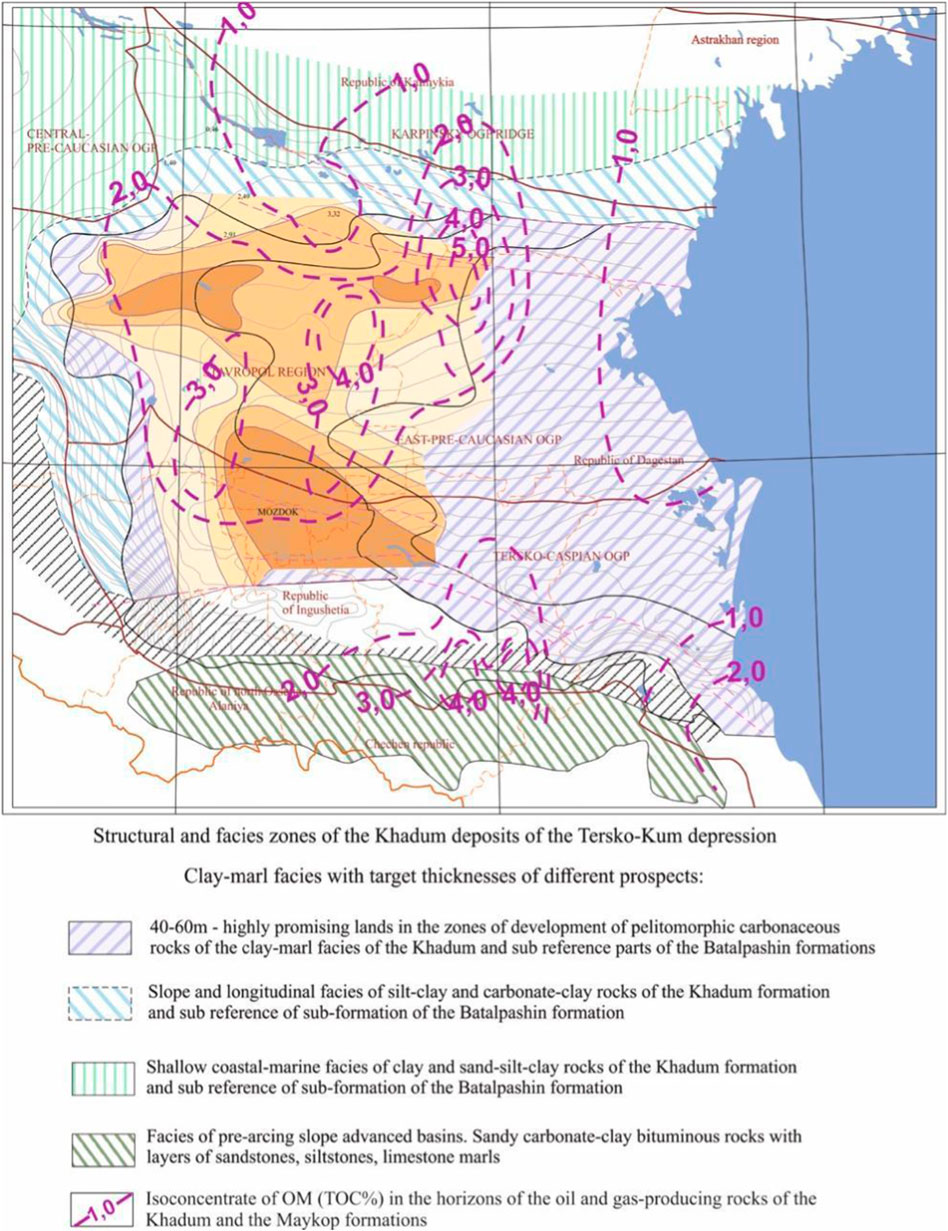
FIGURE 7. Distribution of the Khadum formation within the Tersko-Kum depression (North Caucasian-Mangyshlak OGP) (Bazhenova et al., 2008; Guliyev et al., 2018; Kerimov et al., 2021).
If these results were compared with those previously obtained (Prischepa et al., 2018) (Table 10), when an attempt was made to separate the volumes of hydrocarbons scattered and concentrated in the places of generation based on the composition of OM and tying them to catagenesis zones, they are similar. Therefore, in the Timan-Pechora sedimentary basin, the potential of the Domanik high-carbon formation, previously estimated at 5.3 billion tons of oil, according to this study, ranged from 4.91 to 6.39 billion tons. For gas, estimates reached 4.8 trillion m3, according to this study, from 2.4 to 1,67 trillion m3 (Table 6), which is explained by a decrease in the accepted share of gas preservation at a level some half of that estimated previously in gas-concentration zones.
The final comparison is given in Table 11, which shows a comparison of the current and previously obtained results, as well as the results of specified works (Bazhenova, 1994; Ahlbrandt et al., 2005; Prischepa and Averyanova, 2017; Varlamov et al., 2020; Fortunatova et al., 2021).
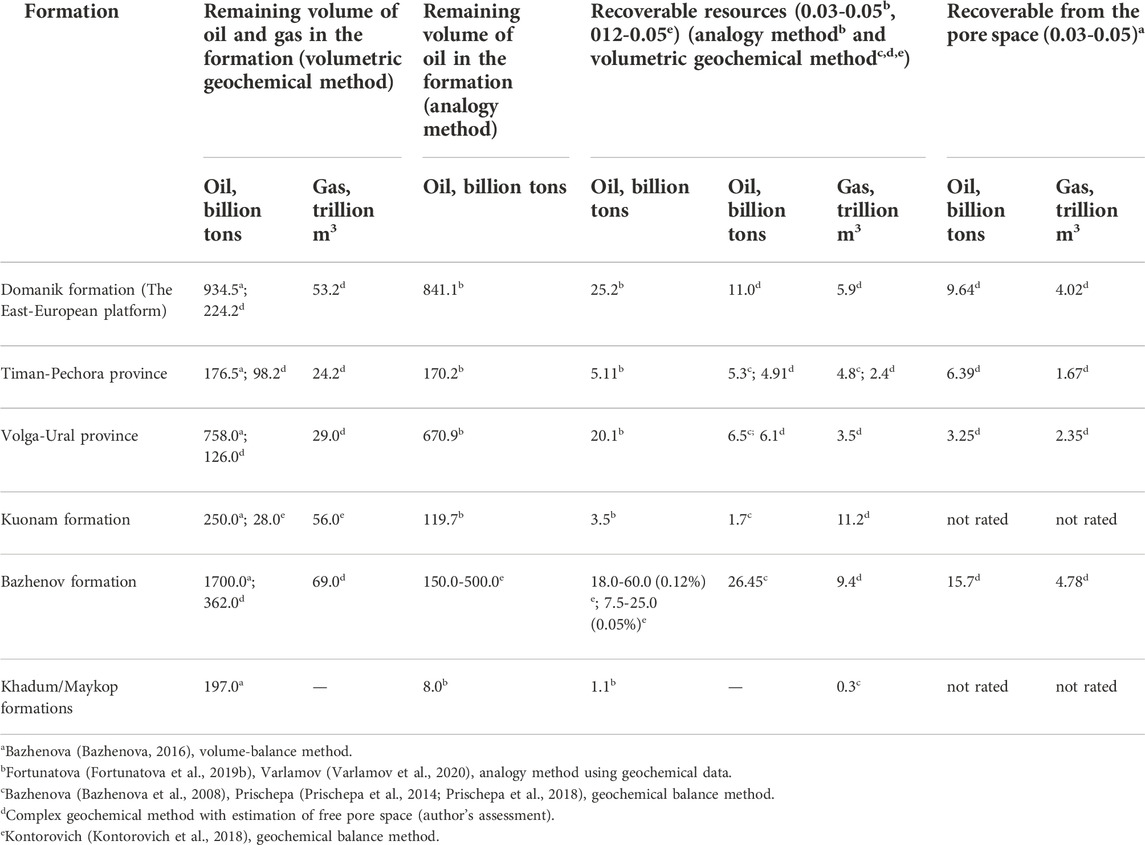
TABLE 11. Comparison of estimates of resources of scattered hydrocarbons and those concentrated in places of their generation.
1. The main high-carbon shale formations of Russia (Bazhenov formation in Western Siberia, Domanik formation, Timan-Pechora and Volga-Ural provinces, Khadum and Maykop formations of the Ciscaucasia, Kuonam formation of the Lena-Tunguska OGP), the estimate of recoverable resources of oil exceeded 40.2 billion, gas–26.8 trillion m3.
2. When using the proposed approach to evaluate hydrocarbons of oil and gas source formations, it is possible to estimate their remaining potential. At the same time, it is important to be able to divide it into the part that has not yet been generated (the early stages of the transformation of OM) and the preserved (non-migrated), represented by mobile hydrocarbons. The latter will be of direct interest to oil and gas companies in the face of high energy prices.
3. In relation to the Domanik and Domanikoid conditions of the Volga-Ural and Timan-Pechora SB, the most significant potential of the mobile part of the oil bituminous is preserved in the catagenesis zones MK21-MK22-MK3 at depths ranging from 1.0 to 2.3 km, which allows recommendations to be made about the most promising areas for their study and development of extraction technologies.
4. For further research into high-carbon formations, a combined study of the geochemistry of OM in comparison with the petrophysical properties of the host thickness is extremely important. The study revealed significant differences between the volumes of pore space and the volumes occupied by bituminous media. The reasons for this discrepancy will be the subject of further research.
5. A significant refinement of the results is possible with a sequential consideration of all intervals of high-carbon formations with the separation of facies most enriched in OM.
The datasets presented in this study can be found in online repositories. The names of the repository/repositories and accession number(s) can be found in the article/supplementary material.
OP: Clarification of prospects of oil and gas content of the domanik strata of the Volga-Ural and Timan-Pechora oil and gas provinces, updating the assessment of oil and gas potential (oil and gas resources) of low-permeability strata, writing the section “Results”, work on the section “Materials and methods”. YN: Processing of statistical materials, processing of geophysical data, analysis of the main directions of development of high-carboniferous formations in Russia, writing the section “Materials and methods” and forming conclusions. VN: Selection and search of literature, methods for calculating organic matter content, writing “Abstract” and “The main areas of development of high-carbon formations in Russia” sections, technical support, including design of drawings and text formatting. XR: Evaluation of the experience of using methods of extraction of shale oil from foreign countries, processing of geochemical data, evaluation and description of the most important areas for exploration. All authors have read and agreed to the published version of the manuscript.
The research was carried out at the expense of a subsidy for the implementation of the State task in the field of scientific activity for 2021 No. FSRW-2020-0014.
The authors declare that the research was conducted in the absence of any commercial or financial relationships that could be construed as a potential conflict of interest.
All claims expressed in this article are solely those of the authors and do not necessarily represent those of their affiliated organizations, or those of the publisher, the editors and the reviewers. Any product that may be evaluated in this article, or claim that may be made by its manufacturer, is not guaranteed or endorsed by the publisher.
Ahlbrandt, T. S., Charpentier, R. R., Klett, T. R., Schmoker, J., and Schenk, C. J. (2005). Global resource estimates from total petroleum systems. AAPG Mem. 86, 324.
Alekseev, A. D., Zhukov, V. V., Strizhnev, K. V., and Cherevko, S. A. (2017). Study of hard-to-recover and unconventional objects according to the principle “collector factory in the reservoir”. J. Min. Inst. 228, 695–704. doi:10.25515/pmi.2017.6.695
Ammosov, I. I., and Tan, S. (1961). Stages of coal change and paragenetic relations of fossil fuels. Moscow, USSR: Nedra.
Averyanova, O. Yu., and Morariu, D. (2016). Assessments variability of hydrocarbon potential of petroleum systems. Petroleum Geol. – Theor. Appl. Stud. 11, 3. doi:10.17353/2070-5379/32_2016
Bazhenova, T. K., and Dakhnova, M. V. (2014). Oil and gas source formations, oils and gases of the Precambrian and lower-middle Cambrian of the Siberian platform. Moscow, Russia: VNIGNI, 126.
Bazhenova, T. K. (2016). Petroleum source formations of the Russian ancient platforms and their petroleum potential. Petroleum Geol. – Theor. Appl. Stud. 11, 4. doi:10.17353/2070-5379/45_2016
Bazhenova, T. K. (1994). “Scale of oil and gas generation in the Timan-Pechora basin,” in Petroleum exploration and production in timan-Pechora basin and barents sea, collected reports of international conference (St. Petersburg, RussiaSt. Petersburg: VNIGRI), 150–157.
Bazhenova, T. K., Shimansky, V. K., Vasilyeva, V. F., Shapiro, A. I., Gembitskaya, L. A., and Klimova, A. I. (2008). Organic geochemistry of the timan-Pechora basin. St. Petersburg, Russia: VNIGRI, 162.
Belonin, M. D., and Makarevich, V. N. (1994). Petroleum exploration and production in timan-Pechora basin and barents sea in Petroleum exploration and production in timan-Pechora basin and barents sea, collected reports of international conference. St. Petersburg, RussiaSt. Petersburg: VNIGRI, 244.
Belonin, M. D., Prischepa, O. M., Teplov, E. L., Budanov, G. F., and Danilevsky, S. A. (2004). Timan-pechora province: Geological structure, oil and gas potential and development prospects. St. Petersburg, Russia: Nedra, 396.
Belozerov, I. P., and Gubaidullin, M. G. (2020). Concept of technology for determining the permeability and porosity properties of terrigenous reservoirs on a digital rock sample model. J. Min. Inst. 244, 402–407. doi:10.31897/pmi.2020.4.2
Bushnev, D. A., and Burdelnaya, N. S. (2013). Modeling of the process of oil formation to carbonaceous shales of the domanik. Petrochemistry 53, 163–170.
Carayannis, E., Ilinova, A., and Chanysheva, A. (2019). Russian arctic offshore oil and gas projects: Methodological framework for evaluating their prospects. J. Knowl. Econ. 11, 1403–1429. doi:10.1007/s13132-019-00602-7
Cherepovitsyn, A. E., Lipina, S. A., and Evseeva, O. O. (2018). Innovative approach to the development of mineral raw materials of the Arctic zone of the Russian Federation. J. Min. Inst. 232, 438–444. doi:10.31897/pmi.2018.4.438
Dakhnova, M. V., Kiseleva, Yu.A., Mozhegova, S. V., and Paizanskaya, I. L. (2018). “Geochemical research tasks for assessing the prospects of oil-bearing in domanik and Bazhenov type deposits,” in VNIGNI-65. People, results and prospects. Editor A. I. Varlamov (Moscow, Russia: VNIGNI), 520.
Egorov, A. S., Vinokurov, I. Yu., and Telegin, A. N. (2018). Scientific, and methodical approaches to increase prospecting efficiency of the Russian Arctic shelf state geological mapping. J. Min. Inst. 233, 447–458. doi:10.31897/pmi.2018.5.447
Espitalie, J., Marquis, F., and Drouet, S. (1993). “Critical study of kinetic modelling parameters,” in Basin modelling: Advances and applications: Special publication (Amsterdam: Norwegian Petroleum Society), 233–242.
Fortunatova, N. K., Shvets-Teneta-Gurii, A., Bushueva, M., Kanev, A., Luchina, S., Avdeeva, A., et al. (2019). Methodology of lithologically screened and lithological oil and gas traps prediction in Upper Devonian-Tournaisian and Lower Permian carbonate plays of eastern Volga-Urals Petroleum Province. Oil gas Geol. 3, 23–38. doi:10.31087/0016-7894-2019-3-23-38
Fortunatova, N. K., Shvets-Teneta-Guriy, A. G., Bushueva, M. A., Kanev, A. S., Luchina, S. A., Avdeeva, A. A., et al. (2019). Method of forecasting structural-lithological and lithological traps of oil and gas in the upper Devon-tournaisan and lower Permian carbonate oil and gas complexes of the East of the Volga-Ural OGP. Oil gas Geol. 3, 23–38. doi:10.31087/0016-7894-2020-6-33-52
Fortunatova, N. K., Varlamov, A. I., Kanev, A. S., Poroskun, V. I., Baranova, A. V., and Bushueva, M. A. (2021). Structure and assessment of the oil potential of carbonaceous carbonate-siliceous domanik deposits in the Volga–Ural oil and gas province. Geol. Geophys. 8 (62), 1132–1152. doi:10.2113/RGG20214351
Gubin, I. A. (2004). The Problem of estimation of reservoir filtration and capacity properties in connection with epigenetic changes. J. Min. Inst. 159, 7–10.
Guidelines for the practical evaluation of undeveloped reserves in resource plays. Monograph 3. – Society of Petroleum Evaluation Engineers, 2010, 86 p.
Guliyev, I. S., Kerimov, V. Yu., Mustaev, R. N., and Bondarev, A. V. (2018). The estimation of the generation potential of the low permeable shale strata of the maikop caucasian series. SOCAR Proc. 1, 4–20. doi:10.5510/ogp20180100335
Halimov, E. M., and Melik-Pashaev, V. S. (1980). On the search for industrial oil accumulations in the Bazhenov formation. Oil gas Geol. 6, 1–9.
Idelson, M. I., Serovikov, E. J., Kazmin, L. L., Weinbaum, S. Ya., and Semenova, E. G. (1990). Features of generation, migration and accumulation of hydrocarbons Domanik formations. Oil gas Geol. 6, 2–5.
Ilinova, A., and Chanysheva, A. (2020). Algorithm for assessing the prospects of offshore oil and gas projects in the Arctic. Energy Rep. 6, 504–509. doi:10.1016/j.egyr.2019.11.110
Jarvie, D. M. (2012). Components and Processes affecting producibility and commerciality of shale oil resource systems. Houston, Texas: HGS Applied Geoscience Conference.
Jarvie, D. M. (2012). Shale resource systems for oil and gas: Part 2—shale-oil resource systems. AAPG Mem. 97, 89–119. doi:10.1306/13321447M973489
Kerimov, V. Yu., Mustaev, R. N., Etirmishli, G. D., and Yusubov, N. P. (2021). Influence of modern geodynamic processes on the structure and tectonics of the Black Sea-Caspian Region. em. 2021, 3–8. doi:10.17580/em.2021.01.01
Kiryukhina, T. A., Bolshakova, M. A., and Stupakova, A. V. (2015). Lithological and geochemical characteristics of domanik deposits of the Timan-Pechora basin. Georesources 61, 87–100.
Kiryukhina, T. A., Fadeeva, N. P., Stupakova, A. V., Poludetkina, E. N., and Sautkin, R. S. (2013). Domanik deposits of the timan-pechora and volga-ural basins. Oil gas Geol. 2013, 76–87. doi:10.18599/grs.19.12
Kiryukhina, T. A., Fadeeva, N. P., Stupakova, A. V., and Poludetkina, E. N. (2013). Domanik deposits of the timan-pechora and volga-ural basins. Oil gas Geol. 3, 6–87.
Kleshchev, K. A., Kontorovich, A. E., Krylov, N. A., and Mironov, Yu. P. (2000). Methodological guide to the quantitative and economic assessment of oil, gas and condensate resources in Russia. Moscow, Russia: VNIGNI, 189.
Kondrasheva, N. K. (2018). “Evaluation of the effectiveness of using oil shale,” in Innovation-based development of the mineral resources sector: Challenges and prospects - 11th conference of the Russian-German raw materials (Boca Raton, Florida, United States: CRC Press).
Kontorovich, A. E., Babin, N. M., Bogorodskaya, L. I., and Vinokur, B. (1967). Thickness and formation conditions of oil in Mesozoic deposits of the West Siberian plain. Leningrad, USSR: Nedra, 224.
Kontorovich, A. E., Moskvin, V. I., Bostrikov, O. I., Danilova, V. P., Fomin, A. N., Fomichev, A. S., et al. (1997). Main oil source formations of the West Siberian basin. Pet. Geosci. 3, 343–358. doi:10.1144/petgeo.3.4.343
Kontorovich, A. E., Nesterov, I. I., Salmanov, F. K., Surkov, V. S., Trofimuk, A. A., and Ervie, Yu. G. (1975). Oil and gas geology of the western Siberia. Moscow, USSR: Nedra, 680.
Kontorovich, A. E., Ponomareva, E. V., Burshtein, L. M., and Glinskikh, V. N. (2018). Distribution of organic matter in rocks of the Bazhenov horizon (Western Siberia). Geol. Geophys. 3, 357–371. doi:10.1016/j.rgg.2018.03.007
Larskaya, E. S. (1983). Diagnostics and methods for studying oil and gas source strata. Moscow, USSR: Nedra, 196.
Lopatin, N. V., Zubairaev, S. L., Kos, I. M., Emets, T. P., Romanov, E. A., and Malchikhina, O. V. (2003). Unconventional oil accumulations in the upper jurassic Bazhenov black shale formation, West Siberian basin: A self-sourced reservoir system. J. Pet. Geol. 26, 225–244. doi:10.1111/j.1747-5457.2003.tb00027.x
Magoon, L. B., and Valin, Z. C. (1994). Overview of petroleum-system case studies. petroleum Syst. – source trap 60, 329–338. doi:10.1306/M60585C20
Makhovikov, A. B., Katuntsov, E. V., Kosarev, O. V., and Tsvetkov, P. S. (2018). “Digital transformation in oil and gas extraction,” in Innovation-based development of the mineral resources sector: Challenges and prospects (Boca Raton, Florida, United States: CRC Press).
Maksimova, S. V. (1970). Ecological and facies features and conditions of Domanik formation. Moscow, USSR: Nauka, 84.
Martirosyan, V., Popova, L., and Vepreva, M. (1998). The petroleum systems of the Pechora Platform foreland, Russia. Pet. Geosci. 4, 339–348. doi:10.1144/petgeo.4.4.339
Methodological guidelines for the quantitative assessment of forecast resources of oil, gas and condensate; VNIGNI: Moscow, USSR, 1983, 214.
Neruchev, S. G., Bazhenova, T. K., Smirnov, S. V., Andreeva, O. A., and Klimova, L. I. (2006). Assessment of potential hydrocarbon resources based on modeling of their generation, migration and accumulation. St. Petersburg, Russia: Nedra, 363.
Neruchev, S. G. (1962). Oil-producing formations and migration of oil. Leningrad: GostoptehizdatUSSR, 224.
Neruchev, S. G., and Smirnov, S. V. (2007). Estimation of potential hydrocarbon resources based on modeling the processes of their generation and formation of oil and gas fields. St. Petersburg, Russia: VNIGRI.
Neruchev, S. G., Vassoevich, N. B., and Lopatin, N. V. (1976). On the catagenesis scale in connection with oil and gas formation Combustible Minerals. Moscow, USSR: Nauka, 47–52.
Pairazian, V. V. (2003). Petroleum geochemistry of the Timan-Pechora basin. First Break 11, 279–286.
Pepper, A. S., and Corvi, P. J. (1995). Simple kinetic models of petroleum formation. Part I: Oil and gas generation from kerogen. Mar. Pet. Geol. 12, 291–319. doi:10.1016/0264-8172(95)98381-e
Peters, K. E., Kontorovich, A. E., and Moldowan, J. M. (1993). Geochemistry of selected oil sand rocks from the central portion of the West Siberian Basin. AAPG Bull. 77, 863–887.
Prischepa, O. M., Averyanova, O. Yu., Grokhotov, E. I., and Nikiforova, V. S. (2018). Methodical approach to the assessment of oil and gas “shale” resources in domanic. Eur. Assoc. Geoscientists Eng. 2018, 1–6. doi:10.3997/2214-4609.201800238
Prischepa, O. M., and Averyanova, O. Yu. (2017). Approaches to assessing the hydrocarbon potential of shale strata on the example of domanik deposits of the Timan-Pechora province. Oil Prov. 1 (9), 19–49. doi:10.25689/NP.2017.1.19-49
Prischepa, O. M., Averyanova, O. Yu., Ilinsky, A. A., and Morariu, D. (2014). Oil and gas of low-permeable shale strata-reserve of the raw material base of hydrocarbons in Russia. St. Petersburg, Russia: VNIGRI, 323.
Prischepa, O. M., Sukhanov, A. A., and Makarova, I. R. (2015). Methods for determining the maturity of sapropelic organic matter in Domanikites and assessing their hydrocarbon resources. Petroleum Geol. – Theor. Appl. Stud. 7, 4–9.
Putikov, O. F., Kholmyanski, M. A., Ivanov, G. I., and Senchina, N. P. (2019). Application of geoelectrochemical method for exploration of petroleum fields on the Arctic shelf. Geochemistry 80, 125498. doi:10.1016/j.geoch.2019.02.001
Rogozina, E. A. (1983). Gas formation during catagenesis of organic matter of sedimentary rocks. Nedra, Leningrad: USSR, 163.
Rzhonsnitskaya, M. A., and Kulikova, V. F. (1990). Decision of the interdepartmental regional stratigraphic meeting on the Middle and Upper Paleozoic of the Russian Platform with regional stratigraphic schemes. Leningrad: VSEGEI, 60. Devonian system (Considered and approved by the MSC of the USSR on January 26, 1989.
Sannikova, I. A., Bolshakova, M. A., Stupakova, A. V., Sautkin, R. S., Suslova, A. A., and Kozlova, E. V. (2017). Hydrocarbon fluids generation scale modeling of Timan-Pechora domanik oil source strata with using various kinetic spectra of organic matter destruction. Georesources 1, 65–79. doi:10.18599/grs.19.8
Schamel, S., Smale, J., Aminov, L., Pesetskaya, V., and Paneva, A. (1994). Petroleum systems of the Pechora basin, Russia: Annual meeting program and abstracts. Annu. Convention Am. Assoc. Petroleum Geol. (AAPG) Soc. Sediment. Geol. (SEPM) 3, 251.
Shimansky, V. K., Neruchev, S. G., Bazhenova, T. K., Prischepa, O. M., and Smirnov, S. V. (1994) “Geochemical modelling of Timan-Pechora oil and gas basin on the basis of balance and kinetic models, in petroleum Exploration and Production in Timan-Pechora Basin and Barents Sea,” in Collected reports of international conference august 15-17, 1994 (St. Petersburg, Russia: VNIGRI), 128–135.
Smith, J. E. (1971). The dynamics of shale compaction and evolution of pore-fluid pressures. Math. Geol. 3, 239–263. doi:10.1007/bf02045794
Sobolev, P. N., Smirnov, E. V., and Sagimbaev, E. T. (2017). Prospects for prospecting for shale oil in the inikan and Kuonam formations in eastern Siberia. Novosibirsk, Russia: SNIIGGiMS.
Solovieva, E. A., and Pavlova, N. A. (2007). Current state of the mineral resource base and prospects for the development of geological exploration in the oil industry. J. Min. Inst. 1, 227–231.
Stupakova, A. V., Fadeeva, N. P., Kalmykov, G. A., Bogomolov, A. Kh., Kiryukhina, T. A., Korobova, N. I., et al. (2015). Criteria for oil and gas search in domanik deposits of the Volga-Ural basin. Georesources 2 (61), 77–86.
Tissot, B., and Velte, D. (1981). Fate of organic matter in sedimentary basins: Oil and gas generation. Moscow, Russia: Oil formation and distribution: Mir, 501.
Torba, D. I., and Nikiforova, V. S. (2019). “Oil recovery increase in kerogen of the Bazhenov formation by a thermal treatment technology,” in Topical issues of rational use of natural resources. Proceedings of the XIV international forum-contest of young researchers (St. Petersburg, Russia: Litvinenko V).
Ulanov, V. L., and Ivanov, E. Yu. (2019). Impact of external factors on national energy security. J. Min. Inst. 238, 474–480. doi:10.31897/pmi.2019.4.474
Ulmishek, G. F. (2003). Petroleum geology and resources of the West Siberian basin, Russia. Reston, United State: U.S. Geological Survey, Reston Virginia, United States of America, 53.
Varlamov, A. I., Mel'nikov, P. N., Poroskun, V. I., Fortunatova, N. K., Petersil'e, V. I., Iutina, M. M., et al. (2020). Unconventional oil reservoirs in high-carbon carbonate-siliceous domanik formations, volga-urals province: Results of studies and future development trends. Oil gas Geol. 6, 33–52. doi:10.31087/0016-7894-2020-6-33-52
Varlamov, A. I., Petersilye, V. I., Poroskun, V. I., Fortunatova, N. K., Komar, N. V., and Shvets-Teneta-Guriy, A. G. (2017). Technique of oil reserves estimation in Domanik deposits. Oil gas Geol. 5, 51–65.
Vassoevich, N. B. (1968). Genesis oil and gas. Moscow USSR: Nauka, 338.The genetic nature of oil from the point of view of organic geochemistry
Keywords: unconventional high-carbon formations, Domanik formation, Bazhenov formation, Kuonam formation, Khadum formation
Citation: Prischepa O, Nefedov Y, Nikiforova V and Ruiming X (2022) Raw material base of Russia’s unconventional oil and gas reserves (hydrocarbons shale strata). Front. Earth Sci. 10:958315. doi: 10.3389/feart.2022.958315
Received: 31 May 2022; Accepted: 27 October 2022;
Published: 17 November 2022.
Edited by:
Chen Zhang, Chengdu University of Technology, ChinaReviewed by:
Wenhui Song, China University of Petroleum, Huadong, ChinaCopyright © 2022 Prischepa, Nefedov, Nikiforova and Ruiming. This is an open-access article distributed under the terms of the Creative Commons Attribution License (CC BY). The use, distribution or reproduction in other forums is permitted, provided the original author(s) and the copyright owner(s) are credited and that the original publication in this journal is cited, in accordance with accepted academic practice. No use, distribution or reproduction is permitted which does not comply with these terms.
*Correspondence: Yuri Nefedov, bmVmZWRvdl95dXZAcGVycy5zcG1pLnJ1
Disclaimer: All claims expressed in this article are solely those of the authors and do not necessarily represent those of their affiliated organizations, or those of the publisher, the editors and the reviewers. Any product that may be evaluated in this article or claim that may be made by its manufacturer is not guaranteed or endorsed by the publisher.
Research integrity at Frontiers

Learn more about the work of our research integrity team to safeguard the quality of each article we publish.